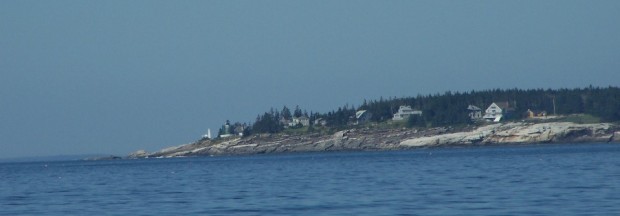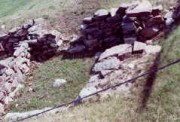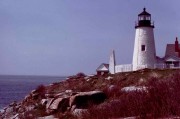
[PEM-ah-kwid] was an early settlement on Pemaquid Point in the town of Bristol in Lincoln County. Early explorers such as David Ingram (1569) and Captain Bartholomew Gosnold (1602), visited the area before the Pilgrims arrived in Massachusetts.
The Popham colonists visited Pemaquid before sailing on to their site on the Kennebec River. They returned a native of the area, Skidwarres, who had been captured by George Weymouth and brought to England.
According to Isaacson,
It seems probable that a group of Bristol (England) merchants maintained a fishing and trading center with a resident agent here as early as 1600 or before. The history of the cellar holes and paved streets is not satisfactorily explained even now.”
The first fort at Pemaquid, then called Jamestown, was a stockade named Shurte’s Fort. Pemaquid was granted to Aldworth and Elbridge in 1631 by the Plymouth Council. . . . Fort Shurte and the settlement was destroyed in 1676 by the Indians. Fort Charles was built in 1677 by order of Governor Andros. In 1689 Pemaquid was again wiped out by the Indians under French direction. (p. 329)
Nearby Fort William Henry was another victim of the French in 1696.
The lighthouse, one of over 700 on the Maine coast, was built in 1827. Although the original building was replaced in 1835, and the original 10 lamps in 1856, the light is still a beacon for ships.
Its first keeper was Isaac Dunham of Bath, who developed a farm, including barns, at the site. On September 16, 1903, fourteen men lost their lives nearby when the schooner George F. Edmonds went down.
One of Maine’s most visited and photographed lighthouses, and a symbol on the Maine quarter, it is situated on dramatic ledges at the tip of the Pemaquid Peninsula. The light is now automated and has recently held a fisherman’s museum.
Additional resources
Bradley, Robert L. The Forts of Pemaquid, Maine: An Archaeological and Historical Study. Augusta, Me. Maine Historic Preservation Commission; Maine Archaeological Society; Maine Bureau of Parks and Recreation. 1994.
Cartland, John Henry. “Pemaquid Harbors and John’s Bay showing ancient settlement of Pemaquid.” [postcard] Repository: Library of Congress Prints and Photographs Division Washington, D.C. Reproduction Number: LC-DIG-ds-02398 http://www.loc.gov/pictures/item/2013645048/ (accessed December 11, 2017)
Castner, Harold Webber. The Story of Ancient Pemaquid: “Metropolis of the New World.” Damariscotta, Me. 1966.
Colonial Pemaquid: State Historic Site. Augusta, Me. Bureau of Parks and Lands, Maine Department. of Conservation. 1998?
Isaacson, Dorris. Maine:A Guide Downeast.
Johnston, John. A History of the Towns of Bristol and Bremen in the State of Maine, including the Pemaquid Settlement. Albany, N.Y. J. Munsell. 1873.
Labrie, Rose. The Story of Pemaquid Light: A History of Pemaquid Light Installation. Hampton, N.H. Hampton Publishing Co. 1954.
Otis, James. The Story of Pemaquid. New York. T. Y. Crowell & Co. 1902.
Parker, Arlita Dodge. A History of Pemaquid; with Sketches of Monhegan, Popham and Castine. Boston. MacDonald & Evans. 1925.
Report of the Commissioners in Charge of the Remains of the Ancient Fortifications at Pemaquid. Augusta, Me. Kennebec Journal Print. 1902. [University of Maine, Raymond H. Fogler Library, Special Collections; Maine State Library; Bangor Public Library]




